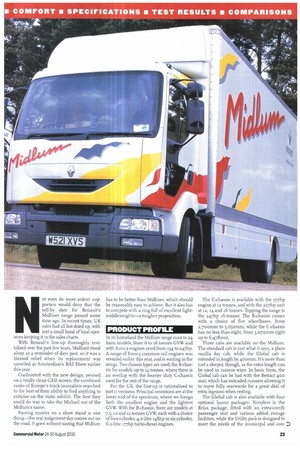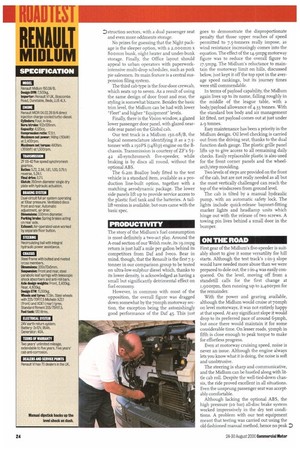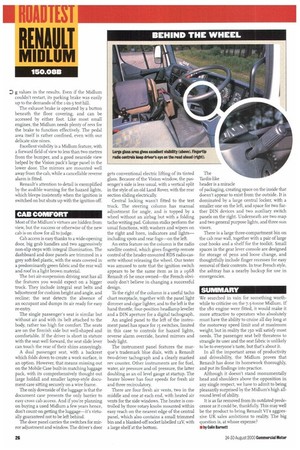N ot even its most ardent supporters would deny that the
Page 25

Page 26

Page 28

If you've noticed an error in this article please click here to report it so we can fix it.
sell-by date for Renault's Midliner range passed some time ago. In recent times, UK sales had all but dried up, with just a small band of loyal operators keeping it in the sales charts.
With Renault's line-up thoroughly revitalised over the past few years, Midliner stood alone as a reminder of days past, so it was a blessed relief when its replacement was unveiled at Amsterdam's RAI Show earlier this year.
Confronted with the new design, penned on a totally clean CAD screen, the combined ranks of Europe's truck journalists searched to the best of their ability to find anything to criticise on the static exhibit. The best they could do was to take the Michael out of the Midlum's name.
Passing muster on a show stand is one thing—the real judgement day comes out on the road. It goes without saying that Midlurn has to be better than Midliner, which should be reasonably easy to achieve. But it also has to compete with a ring full of excellent li tmiddleweights—a tougher proposition.
PRODUCT PROFILE
In its homeland the Midlum range runs to 24 basic models, from 6 to 16 tonnes GVW and with huro-2 engines rated from 134 to 247hp. A range of Euro-3 common rail engines was revealed earlier this year, and is waiting in the wings. Two chassis types are used; the B-chassis for models up to 12 tonnes, where there is an overlap with the heavier duty C-chassis used for the rest of the range.
For the UK, the line-up is rationalised to just II versions. Principal omissions are at the lower end of the spectrum, where we forego both the smallest engine and the lightest GVW. With the B-chassis, there are models at io and 12 tonnes GVW, each with a choice of four-cylinder, 4.0-litre 148hp or six-cylinder, 6.2-litre 177hp turbo-diesel engines.
The C-chassis is available with the 177hp engine at 12 tonnes, and with the 207hp unit at 12, 14 and 16 tonnes. Topping the range is the 247hp 16 -tonner. The B-chassis comes with a choice of five wheelbases, from 2,7 oomm to 5, o5omm, while the C-chassis has no less than eight, from 3,070mm right up to 6,47grinn.
Three cabs are available on the Midlurn. The standard cab is just what it says, a plain vanilla day cab, while the Global cab is extended in length by 400mm. It's more than just a sleeper, though, as the extra length can be used in various ways. In basic form, the Global cab can be had with the Retract 400 seat, which has extended runners allowing it to move fully rearwards for a great deal of extra legroom when resting.
The Global cab is also available with four optional layout packages. Simplest is the Relax package, fitted with an extra-comfy passenger seat and various added storage facilities, while the Utility pack is designed to meet the needs of the municipal and conP
struction sectors, with a dual passenger seat and even more oddments storage.
No prizes for guessing that the Night package is the sleeper option, with a 2,000mm x goomm bunk, night heater and under-bunk storage. Finally, the Office layout should appeal to urban operators with paperworkintensive multi-drop schedules, such as pork pie salesmen. Its main feature is a central suspension filing system.
The third cab type is the four-door crewcab, which seats up to seven. As a result of using the same design of door front and rear, the styling is somewhat bizarre. Besides the basic trim level, the Midlum can be had with lower "Fleetand higher "Equipment" levels.
Finally, there is the Vision window, a glazed lower passenger door panel, with glazed nearside rear panel on the Global cab.
Our test truck is a Midlum 15o.o8/B, the logical nomenclature identifying it as a 7.5tonner with a I5oPS (148110 engine on the Bchassis. Transmission is courtesy of ZF's S542 all-synchromesh five-speeder, while braking is by discs all round, without the optional ABS.
The 6.21/1 Boalloy body fitted to the test vehicle is a standard item, available as a production line-built option, together with a matching aerodynamic package. The lower side panels lift up to provide service access to the plastic fuel tank and the batteries. A taillift version is available, but ours came with the basic spec,
PRODUCTIVITY
The story of the Midlum's fuel consumption is most definitely a two-act play. Around the A-road section of our Welsh route, its i9.trnpg return is just half a mile per gallon behind its competitors from Daf and Iveco. Bear in mind, though, that the Renault is the first 7.5tonner in our comparison group to be tested on ultra-low-sulphur diesel which, thanks to its lower density, is acknowledged as having a small but significantly detrimental effect on fuel economy.
However, in common with most of the opposition, the overall figure was dragged down somewhat by the 70mph motorway section, the exception being the astonishingly good performance of the Daf 45. This just goes to demonstrate the disproportionate penalty that those upper reaches of speed permitted to 7.5-tonners really impose, as wind resistance increasingly comes into the equation. The effect of the 14.9mpg motorway figure was to reduce the overall figure to 17.5mpg. The Midlum's reluctance to maintain the motorway limit on hills, discussed below, just kept it off the top spot in the average speed rankings, but its journey times were still commendable.
In terms of payload capability, the Midlum again lives up to its name, falling roughly in the middle of the league table, with a body/payload allowance of 4,33 tonnes. With the standard box body and air management kit fitted, net payload comes out at just under 2.9 tonnes.
Easy maintenance has been a priority in the Midlum design. Oil level checking is carried out from the driving seat, thanks to the dual function dash gauge. The plastic grille panel lifts up to give access to all remaining daily checks. Easily replaceable plastic is also used for the front corner panels and the wheelarch/step moulding.
Two levels of steps are provided on the front of the cab, but are not really needed as all but the most vertically challenged can reach the top of the windscreen from ground level.
The cab is tilted by a manual hydraulic pump, with an automatic safety lock. The lights include quick-release bayonet-fitting marker lights and headlamp units which hinge out with the release of two screws. A towing pin lives behind a small door in the bumper.
ON THE ROAD
First gear of the Midlum's five-speeder is suitably short to give it some versatility for hill starts. Although the test track's 1-in-3 slope would have needed more abuse than we were prepared to dole out, the r-in-4 was easily conquered. On the level, moving off from a standstill calls for the first change at 1,900rprn, then running up to 2,400rpm for the remainder.
With the power and gearing available, although the Midlum would cruise at 70mph on level motorways, it was not entirely happy at that speed. At any significant slope it would drop to its preferred pace of around 65mph, but once there would maintain it for some considerable time. On lesser roads, omph in fifth is close enough to peak torque to make for effortless progress.
Even at motorway cruising speed, noise is never an issue. Although the engine always lets you know what it is doing, the noise is soft and unobtrusive.
The steering is sharp and communicative, and the Midlum can be hustled along with little cab roll. Despite the well-tied-down chassis, the ride proved excellent in all situations. Even the unsprung passenger seat was acceptably comfortable.
Although lacking the optional ABS, the high pressure (so bar) all-disc brake system worked impressively in the dry test conditions. A problem with our test equipment meant that testing was carried out using the old-fashioned manual method, hence no peak
g values in the results. Even if the Midlum couldn't restart, its parking brake was easily up to the demands of the i-in-3 test hill.
The exhaust brake is operated by a button beneath the floor covering, and can be accessed by either foot. Like most small engines, the Midlum needs plenty of revs for the brake to function effectively. The pedal area itself is rather confined, even with our delicate size nines.
Excellent visibility is a Midlum feature, with a forward field of view to less than two metres from the bumper, and a good nearside view helped by the Vision pack's large panel in the lower door. The mirrors are mounted well away from the cab, while a cancellable reverse alarm is fitted.
Renault's attention to detail is exemplified by the audible warning for the hazard lights, which bleeps insistently when the ignition is switched on but shuts up with the ignition off.
CAB COMFORT
Most of the Midlurn's virtues are hidden from view, but the success or otherwise of the new cab is on show for all to judge.
Cab access is easy thanks to a wide-opening door, big grab handles and two aggressively non-slip steps with integral illumination. The dashboard and door panels are trimmed in a grey soft-feel plastic, with the seats covered in a predominantly green fabric and the rear wall and roof in a light brown material.
The Isri air-suspension driving seat has all the features you would expect on a bigger truck. They include integral seat belts and adjustment for cushion height and angle, and recline; the seat detects the absence of an occupant and dumps its air ready for easy re-entry.
The single passenger's seat is similar but without air and with its belt attached to the body, rather too high for comfort. The seats are on the firmish side but well-shaped and comfortable. If the driver is short in stature with the seat well forward, the seat slide lever can touch the rear of their shins annoyingly.
A dual passenger seat, with a backrest which folds down to create a work surface, is an option. However, that means missing out on the Mobile Case built-in matching luggage pack, with its comprehensively thought out large holdall and smaller laptop-style document case sitting securely on a wire frame.
The only downside of the luggage is that the document case presents the only barrier to easy cross cab access. And if you're planning on buying a used Midlum a few years hence, don't count on getting the luggage—it's virtually guaranteed not to be left behind.
The door panel carries the switches for mirror adjustment and window. The driver's door gets conventional electric lifting of its tinted glass. Because of the Vision window, the passenger's side is less usual, with a vertical split in the style of an old Land Rover, with the rear section sliding electrically.
Central locking wasn't fitted to the test truck. The steering column has manual adjustment for angle, and is topped by a wheel without an airbag but with a folding tacho writing pad. Column stalks perform the usual functions, with washers and wipers on the right and horn, indicators and lights— including spots and rear fogs—on the left.
An extra feature on the column is the radio satellite control, which gives fingertip remote control of the header-mounted RDS radio-cassette without releasing the wheel. Our tester was amused to note that the ignition switch appears to be the same item as in a 1968 Renault 16 he once owned—the French obviously don't believe in changing a successful design.
To the right of the column is a useful tacho chart receptacle, together with the panel light dimmer and cigar lighter, and to the left is the hand throttle, Four-position headlamp leveller and a DIN aperture for a digital tachograph.
An angled panel to the left of the instrument panel has space for 15 switches, limited in this case to controls for hazard lights, reverse alarm override, heated mirrors and body light.
The instrument panel features the marque's trademark blue dials, with a Renault two-driver tachograph and a clearly marked rev counter. Other instruments are for fuel, water, air pressure arid oil pressure, the latter doubling as an oil level gauge at startup. The heater blower has four speeds for fresh air and three recirculatory.
There are four fresh air vents, two in the middle and one at each end, with heated air vents for the side windows. The heater is controlled by three rotary knobs mounted within easy reach on the nearest edge of the central panel, which also contains a small trimmed bin and a blanked-off socket labelled rz.V, with a large shelf at the bottom. The Tardis-like header is a mirade of packaging, creating space on the inside that doesn't appear to exist from the outside. It is dominated by a large central locker, with a smaller one on the left, and space for two further DIN devices and two auxiliary switch panels on the right. Underneath are two map and two general purpose lights, and three sun visors.
There is a large three-compai tinent bin on the cab rear wall, together with a pair of large coat hooks and a shelf for the toolkit. Small spaces in the gear lever console are designed for storage of pens and loose change, and thoughtfully include finger recesses for easy removal of their contents. In true French style, the ashtray has a nearby backup for use in emergencies.
SUMMARY
We searched in vain for something worthwhile to criticise on the 7.5-tonne Midlum. If the i8o engine were fitted, it would make it more attractive to operators who absolutely must have the ability to cruise all day long at the motorway speed limit and at maximum weight, but in reality the 150 will satisfy most needs. The passenger seat belt threatens to strangle its user and the seat fabric is unlikely to be to everyone's taste, but that's about it.
In all the important areas of productivity and driveability, the Midlum proves that Renault has done its homework thoroughly, and put its findings into practice.
Although it doesn't stand monumentally head and shoulders above the opposition in any single respect, we have to admit to being pleasantly surprised by the Midlum's high Around level of ability.
It is as far removed from its outdated predecessor as it could be, thankfully. This may well be the product to bring Renault VI's aggressive UK sales ambitions to reality. The big question is, at whose expense?
• by Colin Barnett








































































































